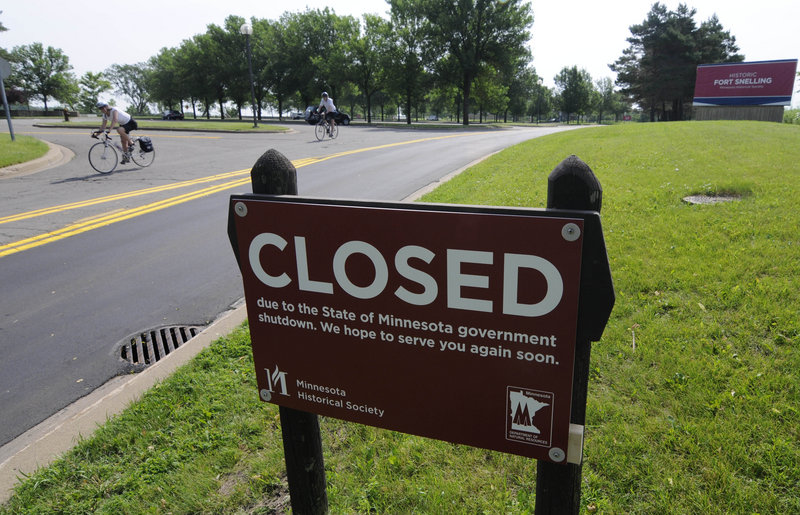ST. PAUL, Minn. – The blind are losing reading services. A help line for the elderly has gone silent. And poor families are scrambling after the state stopped child care subsidies.
Hours after a political impasse forced a widespread government shutdown, Minnesota’s most vulnerable residents and about 22,000 laid-off state employees began feeling the effects Friday. With no immediate end in sight to a dispute over taxes and spending, political leaders spent the day blaming each other for their failure to pass a budget that solves the state’s $5 billion deficit.
Democratic Gov. Mark Dayton and GOP legislative leaders said they had no plans to talk over the holiday weekend, guaranteeing the shutdown will linger at least well into next week. Dayton said he thought lawmakers should spend time in their districts talking to constituents.
In the absence of talks, the shutdown was rippling into the lives of people like Sonya Mills, a mother of eight facing the loss of about $3,600 a month in state child care subsidies. Until the government closure, Mills had been focused on recovering from a May 22 tornado that displaced her from a rented home in Minneapolis. Now she’s adding a new problem to her list.
“It just starts to have a snowball effect. It’s like you are still in the wind of the tornado,” said Mills, 39.
She works at a temporary employment agency and was allowed to take time off as she gets back on her feet — but after the shutdown also has to care for her six youngest children, ages 3 through 14, because she lost state funding for their day care and other programs.
Minnesota is the only state to have its government shut down this year, even though nearly all states have severe budget problems and some have divided governments. Dayton was determined to raise taxes on the top earners to help erase a $5 billion deficit, while the Republican Legislature refused to go along with that — or any new spending above the amount the state is projected to collect.
Here, as in 21 other states, there’s no way to keep government operating past the end of a budget period without legislative action. Even so, only Michigan, New Jersey, Pennsylvania and Tennessee have had shutdowns in the past decade.
The shutdown halted non-emergency roadwork and closed the state zoo and Capitol. More than 40 state boards and agencies went dark, though critical functions such as state troopers, prison guards, the courts and disaster responses will continue.
On Friday, former state Supreme Court Chief Justice Kathleen Blatz started the court-appointed job of sifting through appeals from groups arguing for continued government funding for particular programs.
Nonprofit groups helping the state’s poor have already been hit hard. Some closed down immediately, while others continued services, at least for now.
Some were looking at layoffs, said Sarah Caruso, president and CEO of Greater Twin Cities United Way, which funds 400 programs serving poor people. She said the impact will depend on how long the shutdown lasts.
“If we go well beyond that two-week window, I think then we will start seeing much more significant closure of programs to support the vulnerable, and the long-term financial viability of some of these agencies will really be called into question,” Caruso said.
Copy the Story Link
Send questions/comments to the editors.



Success. Please wait for the page to reload. If the page does not reload within 5 seconds, please refresh the page.
Enter your email and password to access comments.
Hi, to comment on stories you must . This profile is in addition to your subscription and website login.
Already have a commenting profile? .
Invalid username/password.
Please check your email to confirm and complete your registration.
Only subscribers are eligible to post comments. Please subscribe or login first for digital access. Here’s why.
Use the form below to reset your password. When you've submitted your account email, we will send an email with a reset code.